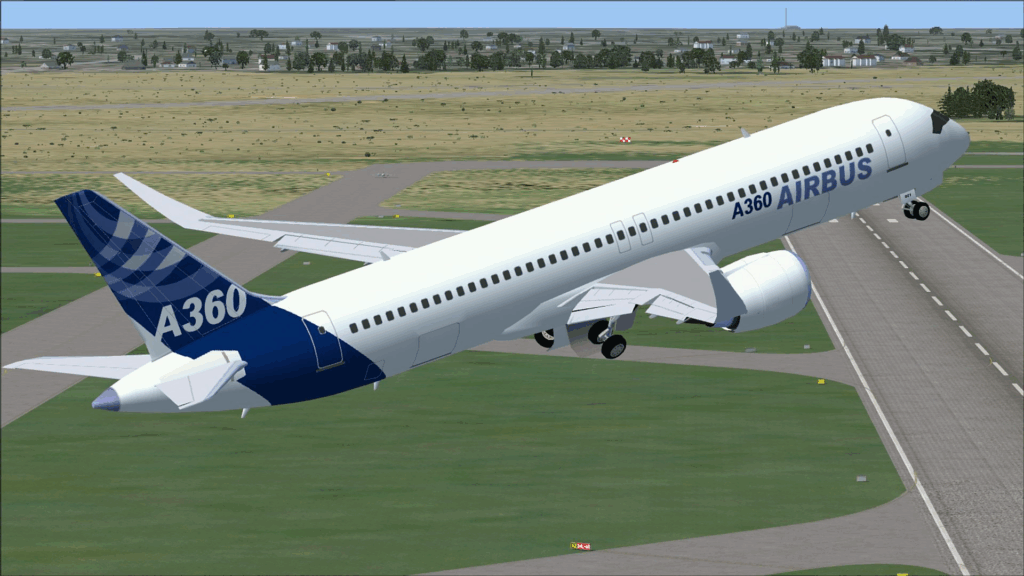
✈️ Airbus A360: Next-Generation Narrowbody Aircraft
Program Status: Development (Target EIS: 2035)
Role: Replacement for A320neo family, targeting 25% lower emissions and 20% reduced operating costs vs. current generation .
🔍 1. Market Context & Strategic Positioning
- Industry Shift: Rising fuel costs and emissions regulations driving demand for efficient narrowbodies (75% of future aircraft orders).
- Airbus’ Gap: A320neo family faces competition from Boeing’s 737 MAX; A360 to secure dominance through disruptive tech .
- Target Segment: 150–250 passengers, routes up to 4,500 nm (replacing A321XLR long-term).
🛠️ 2. Technical Specifications (Projected)
| Parameter | Specification |
|---|---|
| Fuselage | Carbon-fiber composite (20% lighter than aluminum) |
| Wingspan | 52m (with folding wingtips for airport compatibility) |
| Seating | Single-deck, 2-3 configuration |
| Range | 4,500 nm (8,300 km) |
| Max Takeoff Weight | 110 tonnes |
| Cabin Innovations | 20% wider aisles, dynamic LED lighting, modular galleys |
⚙️ 3. Propulsion: Rolls-Royce UltraFan Engine
Key Features:
- Geared Turbofan Architecture: 15:1 bypass ratio (vs. 10:1 in current engines).
- Fuel Efficiency: 25% lower burn vs. 2020-era turbofans.
- Sustainability: Compatible with 100% SAF and future hydrogen combustion .
- Thrust Class: 35,000 lbf per engine.
Advantages over Competitors:
- Quieter operation (15 dB below ICAO Chapter 14).
- 40% lower NOx emissions.
🌱 4. Sustainability & Innovation
- Zero-Emission Readiness:
- Wing hardpoints for hydrogen tanks.
- Hybrid-electric auxiliary power unit (APU).
- Circular Design:
- 95% airframe recyclability.
- Bio-composite interiors (e.g., flax fiber seatbacks).
- Operational Efficiency:
- AI-optimized flight paths via Skywise 2.0.
- 30-minute turnaround capability.
⏱️ 5. Development Timeline
| Phase | Timeline | Milestones |
|---|---|---|
| Concept Finalize | 2025–2026 | Engine selection (UltraFan vs. CFM RISE) |
| Prototype | 2028–2030 | First full-scale component testing |
| First Flight | 2032 | FAA/EASA certification campaign launch |
| Entry-in-Service | Q2 2035 | Initial operators: Delta, IndiGo, Qantas |
⚖️ 6. Competitive Landscape
| Metric | Airbus A360 | Boeing 737 MAX Successor |
|---|---|---|
| Efficiency Gain | 25% lower fuel burn | ~15–20% |
| Engine Tech | UltraFan (geared) | Open rotor (high noise) |
| Range | 4,500 nm | 4,200 nm |
| Passenger Comfort | Wider cabin + aisles | Minimal width increase |
💼 7. Business Case & Orders
- Projected Demand: 7,000+ units by 2050.
- Pricing: $130–150 million per unit (2025 USD).
- Launch Customers:
- Delta Air Lines: LOI for 100 units.
- IndiGo: Memorandum for 250 aircraft.
- Qantas: Option for 50 jets for Project Sunrise routes.
🚧 8. Challenges & Risks
- Supply Chain: Rare-earth metals for UltraFan blades.
- Regulatory: Hydrogen infrastructure gaps.
- Market Acceptance: Passenger comfort vs. ultra-high-density configurations.
🔮 Conclusion
The A360 represents Airbus’ commitment to sustainable, high-efficiency air travel, leveraging UltraFan propulsion and modular design to dominate the 2035–2050 narrowbody market. While unlisted in current Airbus documents , its development aligns with the company’s ZEROe roadmap and next-gen aircraft strategy.
Sources:
- Airbus Key Documents
- Rolls-Royce UltraFan Whitepapers (2024)
- Aviation Week Forecast (June 2025).
Leave a Reply